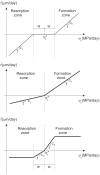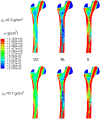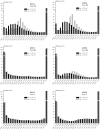On the Use of Bone Remodelling Models to Estimate the Density Distribution of Bones. Uniqueness of the Solution
- PMID: 26859888
- PMCID: PMC4747586
- DOI: 10.1371/journal.pone.0148603
On the Use of Bone Remodelling Models to Estimate the Density Distribution of Bones. Uniqueness of the Solution
Abstract
Bone remodelling models are widely used in a phenomenological manner to estimate numerically the distribution of apparent density in bones from the loads they are daily subjected to. These simulations start from an arbitrary initial distribution, usually homogeneous, and the density changes locally until a bone remodelling equilibrium is achieved. The bone response to mechanical stimulus is traditionally formulated with a mathematical relation that considers the existence of a range of stimulus, called dead or lazy zone, for which no net bone mass change occurs. Implementing a relation like that leads to different solutions depending on the starting density. The non-uniqueness of the solution has been shown in this paper using two different bone remodelling models: one isotropic and another anisotropic. It has also been shown that the problem of non-uniqueness is only mitigated by removing the dead zone, but it is not completely solved unless the bone formation and bone resorption rates are limited to certain maximum values.
Conflict of interest statement
Figures





Similar articles
-
Mechanobiochemical bone remodelling around an uncemented acetabular component: influence of bone orthotropy.Med Biol Eng Comput. 2024 Jun;62(6):1717-1732. doi: 10.1007/s11517-024-03023-0. Epub 2024 Feb 14. Med Biol Eng Comput. 2024. PMID: 38353834
-
Prediction of bone adaptation using damage accumulation.J Biomech. 1994 Aug;27(8):1067-76. doi: 10.1016/0021-9290(94)90223-2. J Biomech. 1994. PMID: 8089161
-
Comparative analysis of bone remodelling models with respect to computerised tomography-based finite element models of bone.Comput Methods Biomech Biomed Engin. 2010 Feb;13(1):71-80. doi: 10.1080/10255842.2010.493728. Comput Methods Biomech Biomed Engin. 2010. PMID: 19697182
-
Biomechanical and molecular regulation of bone remodeling.Annu Rev Biomed Eng. 2006;8:455-98. doi: 10.1146/annurev.bioeng.8.061505.095721. Annu Rev Biomed Eng. 2006. PMID: 16834564 Review.
-
Bone remodelling.Br J Orthod. 1998 May;25(2):101-7. doi: 10.1093/ortho/25.2.101. Br J Orthod. 1998. PMID: 9668992 Review. No abstract available.
Cited by
-
Mechanoregulated trabecular bone adaptation: Progress report on in silico approaches.Biomater Biosyst. 2022 Jul 21;7:100058. doi: 10.1016/j.bbiosy.2022.100058. eCollection 2022 Aug. Biomater Biosyst. 2022. PMID: 36824485 Free PMC article. Review.
-
Computational Analysis of the Influence of Menopause and Ageing on Bone Mineral Density, Exploring the Impact of Bone Turnover and Focal Bone Balance-A Study on Overload and Underload Scenarios.Life (Basel). 2023 Nov 2;13(11):2155. doi: 10.3390/life13112155. Life (Basel). 2023. PMID: 38004295 Free PMC article.
-
A coupled computational framework for bone fracture healing and long-term remodelling: Investigating the role of internal fixation on bone fractures.Int J Numer Method Biomed Eng. 2022 Jul;38(7):e3609. doi: 10.1002/cnm.3609. Epub 2022 May 11. Int J Numer Method Biomed Eng. 2022. PMID: 35485134 Free PMC article.
-
Finite element analysis of bone remodelling with piezoelectric effects using an open-source framework.Biomech Model Mechanobiol. 2021 Jun;20(3):1147-1166. doi: 10.1007/s10237-021-01439-3. Epub 2021 Mar 19. Biomech Model Mechanobiol. 2021. PMID: 33740158 Free PMC article.
-
Numerical Simulation of Mandible Bone Remodeling under Tooth Loading: A Parametric Study.Sci Rep. 2019 Oct 17;9(1):14887. doi: 10.1038/s41598-019-51429-w. Sci Rep. 2019. PMID: 31624317 Free PMC article.
References
-
- Carter D, Hayes W. The behavior of bone as a two-phase porous structure. J Bone Joint Surg Am. 1977; 59: 954–962. - PubMed
Publication types
MeSH terms
LinkOut - more resources
Full Text Sources
Other Literature Sources
Medical

